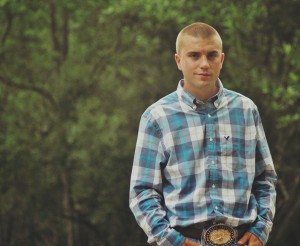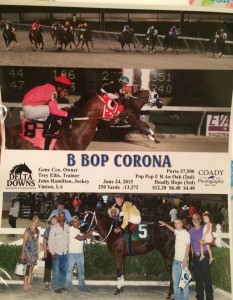Written by Barbara Newtown
Original Publish Date August 2015
 Trey Ellis, trainer of racing Quarter Horses, got his start in Grand Bay, Alabama. He says his family has a farming side and a racing side. The farmers, his mother’s relatives, still raise cotton and peanuts and run about 200 head of cows. The old-timers of Grand Bay were Thoroughbred horse people, but Trey learned about Quarter Horses from his longtime friend Ray Robbins, whom he calls “Uncle.” “All he did was Quarter Horses,” says Trey, “and that’s what I liked, even though I raced Thoroughbreds, too.”
Trey Ellis, trainer of racing Quarter Horses, got his start in Grand Bay, Alabama. He says his family has a farming side and a racing side. The farmers, his mother’s relatives, still raise cotton and peanuts and run about 200 head of cows. The old-timers of Grand Bay were Thoroughbred horse people, but Trey learned about Quarter Horses from his longtime friend Ray Robbins, whom he calls “Uncle.” “All he did was Quarter Horses,” says Trey, “and that’s what I liked, even though I raced Thoroughbreds, too.”
Trey took care of Uncle Ray’s horses, roped babies, and rode match races on the brush tracks (that’s what Alabamians call the bush tracks). He doesn’t miss the brush track experience; he says he did it to make money while he was growing up. “The brush track is not a good place to be. It’s not the crowd I like to be around…too much fighting…and I’m not that kind of person.” Also, the brush tracks didn’t have the best equipment for deciding a photo finish. Arguments broke out after a close race and, of course, everyone blamed the jockeys. Despite being unrecognized, the races involved a lot of money. “Too much fighting and fussing,” says Trey. “I’m a quiet person.”
Ray trained and raced at Louisiana tracks. Trey says, “The day I graduated from high school I had my truck and clothes packed and I came out here to live with him.” Ray put him to work right away, cleaning stalls, exercising horses, breaking babies… “Eventually I was sort of an assistant to him,” says Trey.
His original plan was to become a licensed jockey. But he thought twice when he saw what professional jockeys had to do to make the weight: diets, sweats, and, for some, drugs and eating disorders. “I didn’t want to live like that. Jockey life is a rough life. I don’t know how they do it.”
He got a job working at Robicheaux Ranch in Breaux Bridge, Louisiana. After a year Trey knew that breeding and sales prep was not the side of the horse business that he wanted to stay in. He loves watching and caring for racehorses and training them for competition. He has great praise for the professional operation at Robicheaux, however. He says that he learned about horses from Ray, but he learned how to run a business from the Robicheaux family.
After two years in Louisiana, Trey took the test to get his trainer’s license. “It’s about a three-hour written test,” he says. It’s important to know the racing commission rule book. “If you pass that exam, then they watch you saddle a horse and be hands-on at the barn.” Trey explains that you can’t study a book to prepare for the hands-on part. You have to spend time at the track and get to know real horses.
Trey has 40 horses in training and another 20 at a farm near Delta Downs that he rents from one of his owners. He used to keep up with the paperwork by hand, but now that his business has grown he keeps track of entries, billing, etc. on his laptop with software from equineline.com.
At Trey’s farm the youngsters are usually mounted for the first time in a stall. When they can carry the rider in a quiet circle, they graduate to the round pen. Then they go to the track. Trey wants his young horses to gallop well in both directions; one day they go left, the next day they go right.
Trey knows exactly why he is in the Quarter Horse racing business. “I love the speed,” he says. He also loves the challenge of training a horse to leave the gate like a rocket. Training for fitness and strength is important, but Trey estimates that as much as 20% of all Quarter Horses lack the mental toughness to handle gate training. If you get a bad start in a race that is only 220 yards, you have already lost.
The techniques that a race trainer might employ to get a horse used to the gate would sound familiar even to a dressage trainer: you want the horse to focus forward and understand his job. First, you walk the horse through the open gate, back and forth. Then you close the horse up in the gate. When the horse is used to standing quietly, you open the gate by hand. You get the horse used to the gate flopping and clanging. When the horse can ease out of the gate without getting upset, you move to the next step: tapping the hind legs with a buggy whip so that the horse jumps forward through the opening. Trey says, “Most horses are smart enough to pick up what they are supposed to do. The next time you open the gate, they just automatically go.”
Trey loves racing, but he wishes it were possible to wait until the horses are three years old. He understands that most of the big money is in two-year-old racing. But he points out that getting a horse ready for the Mardi Gras Futurity in February of its second year means that you have to start breezing the horse by the previous November or December. Even if the horse was a January foal, that is still early.
Trey studies legs and feet. He uses a lot of ice—generally he stands his horses in tubs of ice, but some horses get to wear ice boots if they don’t like the tubs. When he wants to add heat to a joint, he wraps it loosely in plastic wrap. Trey doesn’t do his own shoeing, because the shoers he deals with are, as he says, very knowledgeable. He prefers to use shoes that nail on, but some horses need to wear glue-on shoes until their hoof walls get stronger. He says that some Quarter Horses have so little hoof wall that the “white line” is practically on the outside—in other words, there is no hoof wall to nail to.
When it comes to bloodlines, Trey says that he likes seeing Mr Jess Perry on the dam side. He’s done well with horses that had that breeding. In general, Trey believes that the Quarter Horse breeding industry is moving away from Thoroughbred blood: races are getting shorter and the need for instant speed is getting stronger. “When I first started, most races were 350, 400, 440 yards. Now they’re just 220 or 300 yards. There aren’t many quarter-mile horses,” he says.
Trey says that he just races in Louisiana. If a horse goes out of state to run, Trey places it with another trainer. He says, “There’s enough money here. We don’t have to go anywhere else.” Trey thanks Tony Patterson, Executive Director of the Louisiana Quarter Horse Breeders Association, and Leverne Perry, Executive Director Emeritus, for the excellent incentive program for Quarter Horse racing. Trey says, “It’s magnificent.”






You’ve one of the best webpages
Hi there! This blog post couldn’t be written much better!
Reading through this post reminds me of my previous roommate!
He constantly kept preaching about this. I am going to
send this article to him. Pretty sure he will have a very good
read. Thanks for sharing!
Thanks for yor personal marvelous posting!I genuinely enjoyed reading it, you haqppen to be a great author.
I will make certain to bookmark your blog and will often come back later
in life. I want to encourage you to ultimately continue
your great work, have a nice day!
Thanks for finally writing about >Trey Ellis – Off to a Fast Start | The Equine Report <Liked it!
I blog quite often and I really appreciate your content.
Your article has really peaked my interest. I will bookmark your website
and keep checking for new details about once per week. I opted in for your Feed as well.
I absolutely love your site.. Great colors & theme. Did you create this site yourself?
Please reply back as I’m hoping to create my very own blog and would love to learn where you
got this from or exactly what the theme is called.
Cheers!
It’s a basic WordPress template, but the design is custom. The colors — purple and gold — are in honor of Louisiana State University School of Veterinary Medicine.
What’s up friends, fastidious piece of writing and
pleasant arguments commented here, I am genuinely enjoying by these.
Superb post but I was wanting to know if you could write a
litte more on this subject? I’d be very thankful if you could elaborate a little bit further.
Kudos!
Saved as a favorite, I like your blog!